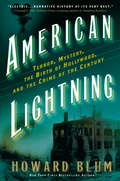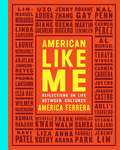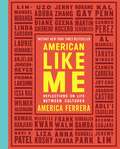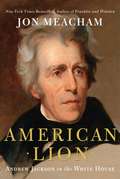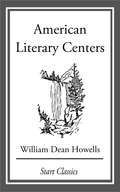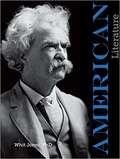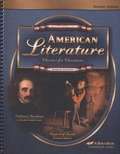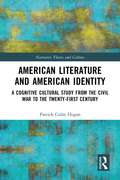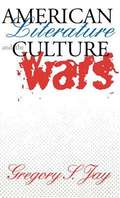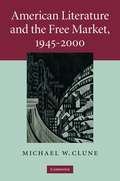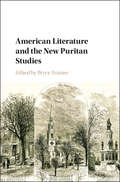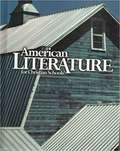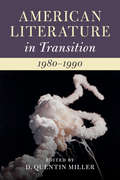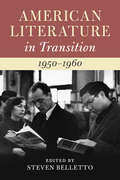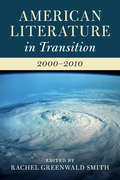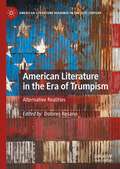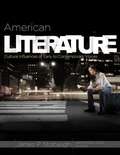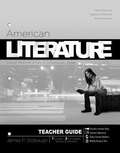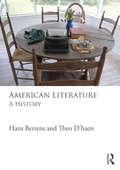- Table View
- List View
American Lightning: Terror, Mystery, and the Birth of Hollywood
by Howard BlumIt was an explosion that reverberated across the country--and into the very heart of early-twentieth-century America. On the morning of October 1, 1910, the walls of the Los Angeles Times Building buckled as a thunderous detonation sent men, machinery, and mortar rocketing into the night air. When at last the wreckage had been sifted and the hospital triage units consulted, twenty-one people were declared dead and dozens more injured. But as it turned out, this was just a prelude to the devastation that was to come. In American Lightning, acclaimed author Howard Blum masterfully evokes the incredible circumstances that led to the original "crime of the century"--and an aftermath more dramatic than even the crime itself. With smoke still wafting up from the charred ruins, the city's mayor reacts with undisguised excitement when he learns of the arrival, only that morning, of America's greatest detective, William J. Burns, a former Secret Service man who has been likened to Sherlock Holmes. Surely Burns, already world famous for cracking unsolvable crimes and for his elaborate disguises, can run the perpetrators to ground. Through the work of many months, snowbound stakeouts, and brilliant forensic sleuthing, the great investigator finally identifies the men he believes are responsible for so much destruction. Stunningly, Burns accuses the men--labor activists with an apparent grudge against the Los Angeles Times' fiercely anti-union owner--of not just one heinous deed but of being part of a terror wave involving hundreds of bombings. While preparation is laid for America's highest profile trial ever--and the forces of labor and capital wage hand-to-hand combat in the streets--two other notable figures are swept into the drama: industry-shaping Filmmaker D. W. Griffith, who perceives in these events the possibility of great art and who will go on to alchemize his observations into the landmark film The Birth of a Nation; and crusading lawyer Clarence Darrow, committed to lend his eloquence to the defendants, though he will be driven to thoughts of suicide before events have fully played out. Simultaneously offering the absorbing reading experience of a can't-put-it-down thriller and the perception-altering resonance of a story whose reverberations continue even today, American Lightning is a masterpiece of narrative nonfiction.
American Like Me: Reflections on Life Between Cultures
by America FerreraAn emotionally and politically charged collection of first person accounts from prominent citizens in a variety of fields about their experiences being first generation Americans, with a powerful foreword written by actress and activist America Ferrera. From award-winning actress and political activist America Ferrera comes an absorbing and fascinating collection of essays written by prominent Americans from a variety of fields about their experiences being first generation Americans. As the daughter of Honduran immigrants, Ferrara is enthusiastic to share dozens of personal stories from notable actors, comedians, athletes, politicians, artists and entrepreneurs about assimilating into American culture while remaining inextricably connected to the mother tongue and the father land. Contributors to the book will include Lin-Manuel Miranda, Roxane Gay, Issa Rae, Kal Penn, Padma Lakshmi, Liza Koshy, Uzo Aduba, Al Madrigal, Anjelah Johnson, Carmen Perez, Wilmer Valderrama, Kumail Nanjiani, Jeremy Lin, Joy Cho, Jenny Zhang, Laurie Hernandez, Michelle Kwan, Ravi Patel, and many others. Ranging from heartfelt to hilarious, the essays in AMERICAN LIKE ME will appeal to anyone from a first generation family; those interested in identity, particularly national identity; and anyone with a complicated relationship to family, culture, and growing up.
American Like Me: Reflections on Life Between Cultures
by America FerreraFrom award-winning actress and political activist America Ferrera comes a vibrant and varied collection of first person accounts from prominent figures about the experience of growing up between cultures. <P><P>America Ferrera has always felt wholly American, and yet, her identity is inextricably linked to her parents’ homeland and Honduran culture. Speaking Spanish at home, having Saturday-morning-salsa-dance-parties in the kitchen, and eating tamales alongside apple pie at Christmas never seemed at odds with her American identity. Still, she yearned to see that identity reflected in the larger American narrative. <P><P>Now, in American Like Me, America invites thirty-one of her friends, peers, and heroes to share their stories about life between cultures. We know them as actors, comedians, athletes, politicians, artists, and writers. However, they are also immigrants, children or grandchildren of immigrants, indigenous people, or people who otherwise grew up with deep and personal connections to more than one culture. <P><P>Each of them struggled to establish a sense of self, find belonging, and feel seen. And they call themselves American enthusiastically, reluctantly, or not at all. Ranging from the heartfelt to the hilarious, their stories shine a light on a quintessentially American experience and will appeal to anyone with a complicated relationship to family, culture, and growing up. <P><b>A New York Times Bestseller</b>
American Lion: Andrew Jackson in the White House
by Jon MeachamAndrew Jackson, his intimate circle of friends, and his tumultuous times are at the heart of this remarkable book about the man who rose from nothing to create the modern presidency. Beloved and hated, venerated and reviled, Andrew Jackson was an orphan who fought his way to the pinnacle of power, bending the nation to his will in the cause of democracy. Jackson's election in 1828 ushered in a new and lasting era in which the people, not distant elites, were the guiding force in American politics. Democracy made its stand in the Jackson years, and he gave voice to the hopes and the fears of a restless, changing nation facing challenging times at home and threats abroad. To tell the saga of Jackson's presidency, acclaimed author Jon Meacham goes inside the Jackson White House. Drawing on newly discovered family letters and papers, he details the human drama-the family, the women, and the inner circle of advisers-that shaped Jackson's private world through years of storm and victory. One of our most significant yet dimly recalled presidents, Jackson was a battle-hardened warrior, the founder of the Democratic Party, and the architect of the presidency as we know it. His story is one of violence, sex, courage, and tragedy. With his powerful persona, his evident bravery, and his mystical connection to the people, Jackson moved the White House from the periphery of government to the center of national action, articulating a vision of change that challenged entrenched interests to heed the popular will-or face his formidable wrath. The greatest of the presidents who have followed Jackson in the White House-from Lincoln to Theodore Roosevelt to FDR to Truman-have found inspiration in his example, and virtue in his vision. Jackson was the most contradictory of men. The architect of the removal of Indians from their native lands, he was warmly sentimental and risked everything to give more power to ordinary citizens. He was, in short, a lot like his country: alternately kind and vicious, brilliant and blind; and a man who fought a lifelong war to keep the republic safe-no matter what it took. Jon Meacham in American Lion has delivered the definitive human portrait of a pivotal president who forever changed the American presidency-and America itself.<P><P> Pulitzer Prize Winner
American Literary Centers: From 'Literature and Life'
by William Dean HowellsWilliam Dean Howells (March 1, 1837 - May 11, 1920) was an American realist author and literary critic... In 1858, he began to work at the Ohio State Journal where he wrote poetry, short stories, and also translated pieces from French, Spanish, and German. He avidly studied German and other languages and was greatly interested in Heinrich Heine. In 1860, he visited Boston and met with American writers James Thomas Fields, James Russell Lowell, Oliver Wendell Holmes, Nathaniel Hawthorne, Henry David Thoreau, and Ralph Waldo Emerson. Said to be rewarded for a biography of Abraham Lincoln used during the election of 1860, he gained a consulship in Venice. On Christmas Eve 1862, he married Elinor Mead at the American embassy in Paris. Upon returning to the U.S., he wrote for various magazines, including Atlantic Monthly and Harper's Magazine. From 1866, he became an assistant editor for the Atlantic Monthly and was made editor in 1871, remaining in the position until 1881. In 1869, he first met Mark Twain, which sparked a longtime friendship. Even more important for the development of his literary style--his advocacy of Realism--was his relationship with the journalist Jonathan Baxter Harrison, who in the 1870s wrote a series of articles for the Atlantic Monthly on the lives of ordinary Americans. He wrote his first novel, Their Wedding Journey, in 1872, but his literary reputation took off with the realist novel A Modern Instance, published in 1882, which described the decay of a marriage. His 1885 novel The Rise of Silas Lapham is perhaps his best known, describing the rise and fall of an American entrepreneur in the paint business. His socialviews were also strongly reflected in the novels Annie Kilburn (1888) and A Hazard of New Fortunes (1890). He was particularly outraged by the trials resulting from the Haymarket Riot
American Literature
by Molly Harrington DuganThis book is an anthology of American Literature. An anthology is a collection of literature written by different authors. The literature can be poems, plays, short stories, essays, parts of novels, folktales, legends, or myths.
American Literature
by Whit JonesThis American literature homeschool curriculum for high school will teach students to analyze major works of American literature from a biblical perspective. The course is authored by Dr. Whit Jones, a homeschool dad and professor at Bryan College.
American Literature (2nd edition)
by Raymond A. St. JohnAmerican Literature for Christian Schools tells the story of the writing done in the United States from its beginnings until the present. It covers key events, major literary movements, and principal players of a dynamic heritage that was born four centuries ago and remains today a vital expression of the heart and soul of the American people. Like other anthologies it showcases as fully as possible the rich variety and impressive appeal of the literature produced in this nation. But the book does more. It tells the story of a culture that has shifted from essential agreement with the truth of God’s Word to almost universal rejection of that truth. At times the change, as reflected in the literature, has been virtually glacial in its pace, hardly discernible to those of its day. At other times the change has been dramatic, apparent even to casual observers.
American Literature Classics for Christians (Fourth Edition)
by Pensacola Christian CollegeLaunch into literature with the exciting stories from Mark Twain, Washington Irving, Edgar Allen Poe, and many more. American Literature is a compilation of short stories, poems, and other selections that are organized by genre to exemplify the specific characteristics of the time period. Learn about the dialects in American legends, irony and satire in the short stories, local color writing during the Realistic period, and the rich imagery during the Romantic Era. With detailed information about the authors and their writing ability, literary terms and definitions, and many selections of American art, this text gives an excellent portrayal of American Literature.
American Literature Postgraduate Course M.A.English Second Year Paper VIII
by Institute of Distance Education University of MadrasThe University of Madras offers an M.A. in English program that includes a comprehensive study of American Literature in the second semester. This course examines significant works and authors from the American literary canon, exploring themes, historical contexts, and cultural impacts. It provides students with critical insights into the evolution of American literary expression. The syllabus is designed to enhance analytical skills and deepen understanding of American literary traditions.
American Literature and American Identity: A Cognitive Cultural Study from the Civil War to the Twenty-First Century (Narrative Theory and Culture)
by Patrick Colm HoganIn recent years, cognitive and affective science have become increasingly important for interpretation and explanation in the social sciences and humanities. However, little of this work has addressed American literature, and virtually none has treated national identity formation in influential works since the Civil War. In this book, Hogan develops his earlier cognitive and affective analyses of national identity, further exploring the ways in which such identity is integrated with cross-culturally recurring patterns in story structure. Hogan examines how authors imagined American identity—understood as universal, democratic egalitarianism—in the face of the nation’s clear and often brutal inequalities of race, sex, and sexuality, exploring the complex and often ambivalent treatment of American identity in works by Charlotte Perkins Gilman, Eugene O’Neill, Lillian Hellman, Djuna Barnes, Amiri Baraka, Margaret Atwood, N. Scott Momaday, Spike Lee, Leslie Marmon Silko, Tony Kushner, and Heidi Schreck.
American Literature and American Identity: A Cognitive Cultural Study from the Civil War to the Twenty-First Century (Narrative Theory and Culture)
by Patrick Colm HoganIn recent years, cognitive and affective science have become increasingly important for interpretation and explanation in the social sciences and humanities. However, little of this work has addressed American literature, and virtually none has treated national identity formation in influential works since the Civil War. In this book, Hogan develops his earlier cognitive and affective analyses of national identity, further exploring the ways in which such identity is integrated with cross-culturally recurring patterns in story structure. Hogan examines how authors imagined American identity—understood as universal, democratic egalitarianism—in the face of the nation’s clear and often brutal inequalities of race, sex, and sexuality, exploring the complex and often ambivalent treatment of American identity in works by Charlotte Perkins Gilman, Eugene O’Neill, Lillian Hellman, Djuna Barnes, Amiri Baraka, Margaret Atwood, N. Scott Momaday, Spike Lee, Leslie Marmon Silko, Tony Kushner, and Heidi Schreck.
American Literature and the Culture Wars
by Gregory S. JayIn this book the author states that he will be: "...questioning both the scope and the purpose of American literary studies. What ends do we pursue in the study and teaching of an "American" literature? Has the idea of a canon of great books reached the end of its usefulness? Where does American literature end and Mexican or Caribbean or Canadian or postcolonial literature begin? Is multiculturalism the end of civilization as we know it or the start of an overdue regeneration of our politics and pedagogy? How has the political economy of making ends meet in an era of downsizing and privatization affected academic freedom and the course of academic study? What happens in the classroom when we try to put an end to the conventional ways in which we have conceived and taught our subject? Playing off the pun in the title of this introduction, then, I want to explore this set of questions about the "ends" of American literary studies. This exploration includes rethinking our ends both in the nominal sense of "pragmatic intention" (goal, aim, objective, design, scheme) and in the verbal sense of "reaching a conclusion" (limit, terminate, cease, halt, expire). By focusing attention on these many ends and the controversial issues they involve, I hope in part to explain how this once arcane academic discipline ended up at the center of the culture wars."
American Literature and the Free Market, 1945–2000
by Michael W. CluneThe years after World War Two have seen a widespread fascination with the free market. Michael W. Clune considers this fascination in postwar literature. In the fictional worlds created by works ranging from Frank O'Hara's poetry to nineties gangster rap, the market is transformed, offering an alternative form of life, distinct from both the social visions of the left and the individualist ethos of the right. These ideas also provide an unsettling example of how art takes on social power by offering an escape from society. American Literature and the Free Market presents a new perspective on a number of wide ranging works for readers of American post-war literature.
American Literature and the New Puritan Studies
by Bryce TraisterThis book contains thirteen original essays about Puritan culture in colonial New England. Prompted by the growing interest in secular studies, as well as postnational, transnational, and postcolonial critique in the humanities, American Literature and the New Puritan Studies seeks to represent and advance contemporary interest in a field long recognized, however problematically, as foundational to the study of American literature. It invites readers of American literature and culture to reconsider the role of seventeenth-century Puritanism in the creation of the United States of America and its consequent cultural and literary histories. It also records the significant transformation in the field of Puritan studies that has taken place in the last quarter century. In addition to re-reading well known texts of seventeenth-century Puritan New England, the volume contains essays focused on unknown or lesser studied events and texts, as well as new scholarship on post-Puritan archives, monuments, and historiography.
American Literature for Christian Schools
by Raymond A. St. John"American Literature for Christian Schools tells the story of the writing done in the United States from its beginnings until the present. It covers key events, major literary movements and principal players of a dynamic heritage that was forn four centuries ago and remains today a vital expression of the heart and soul of the American people."
American Literature in Transition, 1980–1990
by D. Quentin MillerHistory has not been kind to the 1980s. The decade is often associated with absurd fashion choices, neo-Conservatism in the Reagan/Bush years, the AIDS crisis, Wall Street ethics, and uninspired television, film, and music. Yet the literature of the 1980s is undeniably rich and lasting. American Literature in Transition, 1980-1990 seeks to frame some of the decade's greatest achievements such as Toni Morrison's monumental novel Beloved and to consider some of the trends that began in the 1980s and developed thereafter, including the origins of the graphic novel, prison literature, and the opening of multiculturalism vis--vis the 'canon wars'. This volume argues not only for the importance of 1980s American literature, but also for its centrality in understanding trends and trajectories in all contemporary literature against the broader background of culture. This volume serves as both an introduction and a deep consideration of the literary culture of our most maligned decade.
American Literature in Transition: American Literature in Transition, 1950–1960
by Steven BellettoAmerican Literature in Transition, 1950-1960 explores the under-recognized complexity and variety of 1950s American literature by focalizing discussions through a series of keywords and formats that encourage readers to draw fresh connections among literary form and concepts, institutions, cultures, and social phenomena important to the decade. The first section draws attention to the relationship between literature and cultural phenomena that were new to the 1950s. The second section demonstrates the range of subject positions important in the 1950s, but still not visible in many accounts of the era. The third section explores key literary schools or movements associated with the decade, and explains how and why they developed at this particular cultural moment. The final section focuses on specific forms or genres that grew to special prominence during the 1950s. Taken together, the chapters in the four sections not only encourage us to rethink familiar texts and figures in new lights, but they also propose new archives for future study of the decade.
American Literature in Transition: American Literature in Transition, 2000–2010
by Rachel Greenwald SmithAmerican Literature in Transition, 2000-2010 illuminates the dynamic transformations that occurred in American literary culture during the first decade of the twenty-first century. The volume is the first major critical collection to address the literature of the 2000s, a decade that saw dramatic changes in digital technology, economics, world affairs, and environmental awareness. Beginning with an introduction that takes stock of the period's major historical, cultural, and literary movements, the volume features accessible essays on a wide range of topics, including genre fiction, the treatment of social networking in literature, climate change fiction, the ascendency of Amazon and online booksellers, 9/11 literature, finance and literature, and the rise of prestige television. Mapping the literary culture of a decade of promise and threat, American Literature in Transition, 2000-2010 provides an invaluable resource on twenty-first century American literature for general readers, students, and scholars alike.
American Literature in the Era of Trumpism: Alternative Realities (American Literature Readings in the 21st Century)
by Dolores ResanoThis edited collection offers an exploration of American literature in the age of Trumpism—understood as an ongoing sociopolitical and affective reality—by bringing together analyses of some of the ways in which American writers have responded to the derealization of political culture in the United States and the experience of a ‘new’ American reality after 2016. The volume’s premise is that the disruptions and dislocations that were so exacerbated by the political ascendancy of Trump and his spectacle-laden presidency have unsettled core assumptions about American reality and the possibilities of representation. The blurring of the relationship between fact and fiction, bolstered by the discourses of ‘fake news’ and ‘alternative facts,’ has not only drawn attention to the shattering of any notion of ‘shared’ reality, but has also forced a reexamination of the purpose and value of literature, especially when considering its troubled relation to the representation of ‘America.’ The authors in this collection respond to the invitation to reassess the workings of fiction and critique in an age of Trumpism by considering some of the most recent literary responses to the (new) American realit(ies)—including works by Colson Whitehead, Ben Winters, Claudia Rankine, Gary Shteyngart, Jennifer Egan, and Steve Erickson, to name but a few—, some of which were composed in the run-up to the 2016 election but were able to accurately and incisively imagine the world to come.
American Literature, Grade 11, Volume 1 (HMH Into Literature)
by Kylene Beers Elena Izquierdo Martha HougenNIMAC-sourced textbook
American Literature, Grade 11, Volume 2 (HMH Into Literature)
by Kylene Beers Elena Izquierdo Martha HougenNIMAC-sourced textbook
American Literature-Student
by James P. StobaughEnjoy beloved classics while developing vocabulary, reading, and critical thinking skills! Each literature book in the series is a one-year course Each chapter has five lessons with daily concept-building exercises, warm-up questions, and guided readings Easy-to-use with suggested reading schedules and daily calendar Equips students to think critically about philosophy and trends in culture, and articulate their views through writing A well-crafted presentation of whole-book or whole-work selections from the major genres of classic literature (prose, poetry, and drama), each course has 34 chapters representing 34 weeks of study, with an overview of narrative background material on the writers, their historical settings, and worldview. The rich curriculum's content is infused with critical thinking skills, and an easy-to-use teacher's guide outlines student objectives with each chapter, providing the answers to the assignments and weekly exercises. The final lesson of the week includes both the exam, covering insights on the week's chapter, as well as essays developed through the course of that week's study, chosen by the educator and student to personalize the coursework for the individual learner.
American Literature-Teacher
by James P. StobaughEnjoy beloved classics while developing vocabulary, reading, and critical thinking skills! Each literature book in the series is a one-year course Each chapter has five lessons with daily concept-building exercises, warm-up questions, and guided readings Easy-to-use with suggested reading schedules and daily calendar Equips students to think critically about philosophy and trends in culture, and articulate their views through writing A well-crafted presentation of whole-book or whole-work selections from the major genres of classic literature (prose, poetry, and drama), each course has 34 chapters representing 34 weeks of study, with an overview of narrative background material on the writers, their historical settings, and worldview. The rich curriculum's content is infused with critical thinking skills, and an easy-to-use teacher's guide outlines student objectives with each chapter, providing the answers to the assignments and weekly exercises. The final lesson of the week includes both the exam, covering insights on the week's chapter, as well as essays developed through the course of that week's study, chosen by the educator and student to personalize the coursework for the individual learner.
American Literature: A History
by Hans Bertens Theo D'haenThis comprehensive history of American Literature traces its development from the earliest colonial writings of the late 1500s through to the present day. This lively, engaging and highly accessible guide: <p><p> offers lucid discussions of all major influences and movements such as Puritanism, Transcendentalism, Realism, Naturalism, Modernism and Postmodernism <p> draws on the historical, cultural, and political contexts of key literary texts and authors <p> covers the whole range of American literature: prose, poetry, theatre and experimental literature <p> includes substantial sections on native and ethnic American literatures <p> explains and contextualises major events, terms and figures in American history. <p> This book is essential reading for anyone seeking to situate their reading of American Literature in the appropriate religious, cultural, and political contexts.
